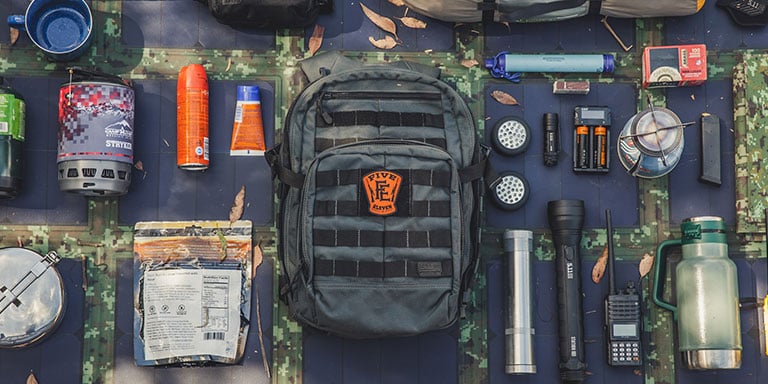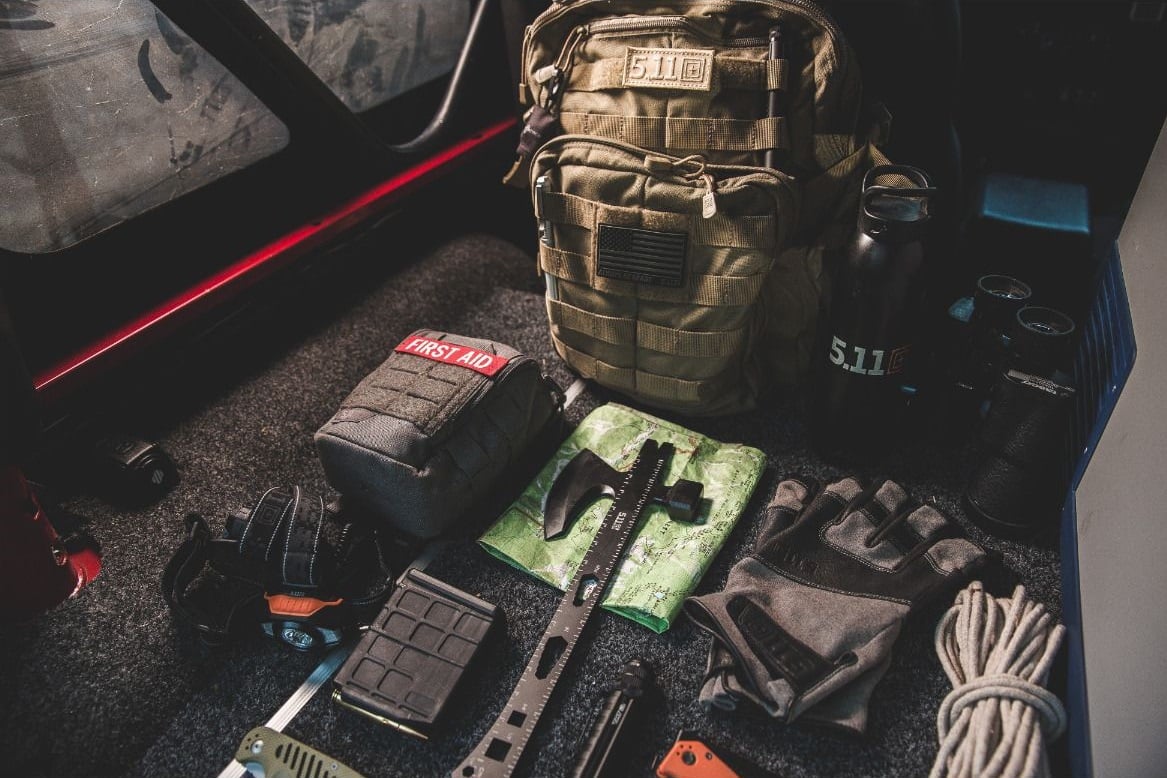HOW TO ORGANIZE TACTICAL BACKPACK PACKING
Proper organization inside a tactical backpack depends on two things: your mission and your comfort. You need to be able to store everything you need and carry it comfortably, so you need to start with the right equipment. The specific needs of your mission should determine your final decision, but there are a few features that are standard on any quality tactical backpack:
- Spacious main storage compartment
- External zippered pockets
- Reinforced handles for grabbing and carrying when loading into a car or at the airport
- MOLLE system or other similar modern attachment platform
- Internal mesh pockets and special compartments
- Water-repellent coating
- External compression straps
- Internal compartment for drinking hydration
WHAT TO PACK IN YOUR TACTICAL BACKPACK
The contents of your tactical backpack depend on what you do. You will need different items for a day than you would for a week or more in the field, but there is also an emergency standby that every person should have, always ready for any situation. Here are the main items you need in a tactical backpack:
- First aid kit or summary of IFAK
- Food, including high protein, which increases energy
- Personal hygiene products
- Tools and utilities
- Water
If you’re packing a survival backpack, you’ll also need these basic items:
- Bedding
- Clothing
- Communication equipment
- Items for self-defense
- Set for starting a fire
- Flashlight
- Shelter (shelter, awning, etc.)

HOW TO PROPERLY PACK A TACTICAL BACKPACK
Think of assembling a 24-hour tactical backpack like building a pyramid. Place heavy items on the bottom, medium-weight items in the middle, and light items on top. This configuration is the best for your back and is generally the easiest to carry, especially if you have a long ride ahead of you.
Use your pack’s external compartments or MOLLE pouches for items you need to access frequently and easily, such as flashlights, tactical knives or multitools, radios, and first aid kits.
PACKING FROM THE BOTTOM OF YOUR BACKPACK
The bottom of your pack is for accessories that you only need to access when you’re done carrying it for the day. That is – your bedding, extra clothing and most toiletries are usually on the bottom for convenience, as well as all your heaviest gear such as fixing tools.
Packing MIDDLE
Your tent or shelter, poncho liner, or whatever you use to set up camp for the night lies in the middle of your pack. The middle of your pack is also a great place for extra food, water, and other items you probably won’t need while you’re on the go.
WHAT TO PACK ON TOP OF YOUR TACTICAL BACKPACK
Leave a change of socks, ponchos, self-defense items and navigation equipment here – on the top layer of your pack so you can easily access it. Snacks, tablets for water purification and other small items of frequent use should be placed there.
EQUIPMENT for EXTERNAL gluing (grooves)
If your tactical pack is MOLLE compatible, make the most of it. Attach cutlery, first aid, eye and hearing protection, a holster and other essentials to the convenient molle platform.
HOW TO PACK A SURVIVAL BACKPACK
Unlike a tactical backpack, a survival backpack is meant to support you when you’re far from civilization. It should have enough gear to last you at least 72 hours and longer, unless you anticipate a short-term emergency or purposefully set off on such an adventure. You include the same basic gear as described above, as well as additional food, water and safety gear, a tent or one-person tent, and gear for self-defense and possible hunting.
The key to properly packing a tactical backpack is to put the heavier, less frequently needed items at the bottom and work your way up, loading lighter items. Your backpack should provide easy access to the gear you need most when you’re on the go – packing from the bottom up makes this extremely possible.
HOW TO PACK YOUR TACTICAL BACKPACK FOR ADVENTURE TRAVEL
It’s a lot easier to get up and go at a moment’s notice if you pre-pack your emergency backpack for future adventures, but you need to know what to pack and how to do it right. Everything is similar with a shoulder bag. Here’s what you should pay attention to when buying a backpack to carry everything you need:
- Stabilizing chest strap with adjustable length
- External compression straps
- Convenient handle for carrying
- Compartment for a flask or hydraulic system
- MOLLE platform
- Multiple separate compartments to keep your gear separate
- Spacious main storage area
Some of the things you carry in a bag of this type are non-negotiable, but you can also increase your comfort by taking everything else you need, if you have enough space:
- sunglasses
- Sunscreen cream
- Towel
- Comb
- Wipes for the body
- Dry shampoo
- Headphone
- A cover or case for your phone
- Protein food
- Hand sanitizer
HOW TO ORGANIZE YOUR TACTICAL BACKPACK
Your tactical backpack is more useful when you pack it properly. Packing different gear into different pockets is standard and easy, but is it practical? Dedicated compartments keep everything organized and easy to find, so you don’t have to stand rummaging through your backpack to find and retrieve a knife or flashlight. Use these tips to effectively pack your tactical backpack:
- Place heavy items at the bottom for the safest weight distribution, especially if you are using a large backpack.
- Keep self-defense items and the most essential equipment closer to the top, preferably in a separate compartment, to make them easier to find and quickly access in a stressful situation
- Choose a backpack with more space inside.
- Pack a variety of high-calorie snacks in your backpack.
- Pack a spare set of clothes (underwear) in a mesh bag in case you need to change on the fly – mesh is a great way to store and air out the dirty clothes you’re changing into too
- Keep extra waterproof or plastic bags in your bag, just in case.
- If a few interior pockets aren’t enough for your bag, keep your gear in these clear plastic bags.
Packing the right backpack is a matter of personal preference, but these similar tips for backpacking will help you make the process of quickly using the gear you need easier.

HOW TO CHOOSE AN ANXIOUS BACKPACK
Choosing the right backpack, which is essentially tactical and adapted to the necessary equipment, is half the battle. If you need more gear than a single backpack can hold to cover everyone in your family, opt for an additional backpack – another family member can carry it, or you can quickly sling it over your shoulder. Another option is to have each family member pack their own backpack to ensure everyone in the family is prepared for any situation.
Here are the main features that every bag needs:
- A MOLLE system so you can attach extra packs and other gear depending on each unique situation
- Compression straps to compress equipment or clothing (down jacket, insulation, or poncho)
- Front and main compartments with a zipper and internal partitions or compartments
- Built-in compartment for a flask or hydraulic system
- Belt strap on the waist for fixation to the body, and strap on the sternum for easy carrying
- Carrying handle
It’s not enough just to have an emergency backpack – you also need to pack it correctly. Here are the essential items to put in any military backpack:
- Radio receiver and radio station on batteries
- Cash
- Emergency thermal blanket
- Additional batteries for radio stations
- Extra keys to your house and car
- Extra socks
- First aid items (first aid kit with medicines)
- Flashlight
- Calorie snacks
- Important documents in closed plastic bags
- Than
- Lighter and matches
- Multi-tool
- Personal hygiene items
- Spare chargers for electronics
- Tablets for water purification
- Waterproof bags
Other items to include depend on the type of emergency you’re preparing for – you may need things like a tent, a water purification kit and a blanket, which usually goes beyond a standard backpack. It may not always be practical to pack a backpack for each member of your family. If you are limited in space, you may have to compromise on optional items, or use the MOLLE system to attach extra items to the outside of your pack.
YOUR BACKPACK FOR EXTRAORDINARY SURVIVAL
If you have the space, here are some optional items that can make an emergency a little less difficult:
- Opener for cans and dishes
- Canned food
- Chemical light
- Complete IFAK kit
- A full-fledged awning
- Hand sanitizer
- LED powerful lantern
- MRE
- Poncho
- Survival blankets
- Tactical gloves
- Toilet paper
